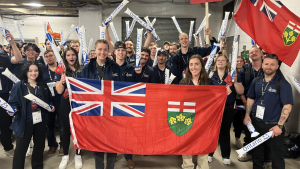Planning and design work have begun for a new, $189-million indoor aquatics facility in Regina that will have a deep geothermal energy heating system and aim to achieve net-zero emissions.
The project will be one of the largest investments in recreation the city has ever made. The vision for the new facility is an accessible, inclusive and sustainable community destination for area residents.
The structure is being built to the east of the existing Lawson Aquatic Centre and Fieldhouse on the Sportplex site at 1717 Elphinstone St. The space is currently used for parking. The aging Lawson building, built in 1975, will be decommissioned after the new facility is operational. Construction will start in 2025.
“The project is in the early stages of design, working through items such as site and facility planning, program validation and other project elements,” says a statement compiled for the Journal of Commerce by the project team working on the venture. “The next steps include continuing the design process and engaging a construction manager.
“The project team continues to engage with key interested parties and will be doing broader community outreach later in the design process.”
The complex will include two 50-metre tanks for competitive swimmers and amenities required for national competition for water polo, speed swimming, artistic swimming and a leisure pool space with modern recreational aquatic amenities.
In addition to these spaces, multi-purpose spaces to support aquatics and provide additional programming and bookable spaces for the community will be developed. Outdoor programming will include a playground and spray pad along with other elements.
“Once complete, it will provide a great opportunity for our community to host national-level aquatic competitions, while also providing exciting recreation opportunities for residents of all ages,” the project team states.
The concept for the aquatic complex fits with the city’s Energy and Sustainability Framework and ambitions to be net-zero by 2050. The recreation master plan for the city identified the expansion of the quantity and quality of indoor pool facilities as a top priority.
“While the specifics will be identified through further engagement, the facility is intended to demonstrate the city’s leadership and commitment to reconciliation,” the project team advised while ensuring the facility is environmentally and financially sustainable and designed in a responsible manner that provides value over the long-term to the public.
The design team is led by HCMA of Vancouver with subconsultants P3A Architecture, AME Group, RC Strategies and Gensler. Third-party project management is being led by Colliers Project Leaders of Regina.
The project includes the design and construction of a deep geothermal heating system, which will provide clean energy to meet nearly all of the heating needs for the new indoor aquatic facility. The system consists of a heat exchanger plant, wellheads and a supply and return well which go down to depths of 2,200 metres.
“The deep geothermal heating system will be the first in Saskatchewan, and one of only a few around the world,” the project team states. “The environmental benefits and long-term cost savings are anticipated to make the facility a showcase for innovation.”
The project team expects the deep geothermal well drilling and construction will be a challenge. It is the first one in an urban environment. The work will be further analyzed as more design work is completed.
Deep geothermal heating works by pumping naturally occurring hot brine water found deep below the earth’s surface and transferring the energy from the hot water pipe to the pool and ventilation systems in the new facility. After the heat is extracted from the brine water, the cool water is returned deep below the earth’s surface where it can naturally be reheated. This provides a cleaner source of energy than a traditional natural gas energy source.
“Warm water from over two kilometres below the earth’s surface is pumped to surface. Heat is used in the indoor aquatics heating systems, then the cool water is returned to the original water source within the earth.”
A geothermal feasibility study completed by the city in 2023 confirmed with a high level of confidence that the geothermal resource is sustainable for a minimum of 70 years.
The project has the opportunity to include solar generation, which will further offset operational electrical loads and incorporate renewable energy sources.
The city figures the annual net greenhouse gas emission reduction will be 8,670 tonnes of CO2 equivalent, which is the same as removing 1,880 gas cars off the road.
Project phasing will require careful planning to ensure the Lawson Aquatic Centre and Fieldhouse can remain operational and open to the public while construction activity is underway on the rest of the site.
The federal government is investing $51.3 million in the new facility project, the Government of Saskatchewan is investing $42.7 million, and the city is contributing $34.2 million.




Recent Comments